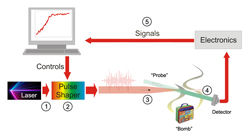Then something catches your eye: Is that an unattended lunchbox underneath a park bench? Upon closer look, you notice that the box is misshapen and appears to be leaking. You immediately pull out your cell phone and dial 9-1-1.
For anyone who has spent a significant amount of time in an urban setting, the scene of a bomb squad responding to a report of a suspicious package is all too familiar. But just how do they determine if that lunchbox is someone’s leftovers or a lethal weapon? The most common way is an imaging technique called spectroscopy.
As its name suggests, spectroscopy uses the color spectrum to shed light on a package’s makeup. Since it uses visible light only, spectroscopy can’t see through a lunchbox. What it can see is residue, or microscopic schmutz, on the box’s outer layer, which can provide telltale clues about what’s inside.
Using spectroscopy, the bomb squadder will beam a laser at the package, then compare the reflected "light signature"—an optical fingerprint, if you will—against a library of known signatures for chemical compounds, such as nitroglycerin. If there’s nitro inside, chances are that some of it will be found in the package’s residue.
This method presents two problems. First, there’s distance. Many threat detection methods require either the person or the detector to be physically near the bomb, making spectroscopy extremely dangerous. Second, approaches like spectroscopy, which rely on reflected light, often are not sensitive or selective enough, especially in the real world where chemical signatures may overlap or be contaminated. Think of light signatures as fingerprints. Capturing a fingerprint from a clean surface is not especially difficult—all one needs is some cellophane tape. But in real life, surfaces are anything but clean, and dust, French fry grease, or even ink stains can cause a backpack or lunch pail to bear small deposits of several different chemicals, each with a unique optical fingerprint. To minimize false alarms, a detector must be both sensitive and selective."Spectroscopy is good, but it only gets you so far," says Eric Houser, a program manager in the Explosives Division of the Department of Homeland Security’s Science and Technology Directorate (S&T). The wave of the future may lie in a technology called optimal dynamic detection (ODD), which overcomes many of spectroscopy’s limitations.
The ODD project began in the summer of 2008, when researchers from Princeton University and Los Alamos National Laboratory pitched the concept to S&T. As a result, the Directorate signed a contract to fund research at the two labs for a proof of concept. A year and a half later, after several rounds of successful tests, researchers have successfully demonstrated the science of ODD. The goal now: to develop a portable prototype in the next three years that can be field-tested.
But back to the science, which of course is the real eye-opener. "At the risk of oversimplifying, this is quantum control applied to explosives detection," warns Houser.
Here’s how ODD works:
1. A bomb technician beams a "raw" laser pulse toward a suspicious bag, looking for a specific explosive.
2. The pulse passes through an electro-optical filter, gaining clarity as it is bent through lenses, reflected by mirrors and amplified by chips. When the technician tunes the laser to a new frequency, the filter reshapes the laser’s pulse. As it is bent, reflected, and electronically processed, the pulse changes amplitude.
3. The shaped pulse hits the chemical environment around the lunchbox and excites the energy state of the material of interest, emitting an energy "signature." Since the pulse was precisely defined, so is the signature.
4. A second laser, called an analyzing "probe," is beamed through the excited molecules, measuring its spectrum. The probe beam passes into an electro-optical detector stationed on the other side of the target.
5. The pulse laser’s final shape is stored and analyzed. If the signature looks like that of an explosive, it can conclusively be traced to the explosive molecules that emitted it, which may be found on the bag’s fabric or zipper.
In this way, ODD reduces background signals, which interfere with the identification process of a potential bomb, and amplifies the return signal, which illuminates the threat. The light energy going in is precisely defined, which makes it easier than spectroscopy to read the energy coming out.
"In evaluating a potential bomb, you’re looking for a needle in a haystack," explains Houser. "ODD helps bring the needle to the forefront." In a word, ODD offers control. And with greater control comes greater accuracy. The result may well save precious minutes when a minute saved can means scores of lives.








No comments:
Post a Comment